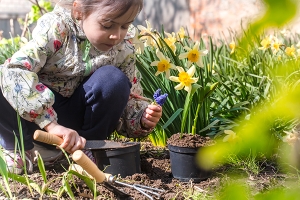
Many of us in the U.S. ring in the new year by watching the ball drop in Times Square, kissing loved ones at midnight, and making resolutions (or setting intentions) to improve health and productivity. We also often gather with friends and family for shared food, drink and merriment. If you grew up in the south, a meal including Hoppin’ John (black-eyed peas), collard greens and cornbread is likely on the menu.
Some people celebrate New Year’s with traditions from other cultures. My family, for example, eats 12 seeded grapes at midnight. This is supposedly for luck, but we mostly do it to honor my husband’s Panamanian heritage. In Panama, and throughout many Latin American countries, it is also common to burn muñecos (life-size effigies made of straw) to destroy evil spirits and make way for good fortune in the new year.
No matter your background, establishing New Year’s traditions within your family is important. Just like adults, kids benefit from signaling closure to the previous year and starting out fresh. To help discover new ideas, here are some of the many ways that people celebrate around the globe.
Get Dressed Up
Around the world, people often don their finest outfits to celebrate the new year. According to Encinitas resident Olivier Bourgeot, there’s an expression for this in France, “se mettre sur son 31.” Roughly translated, this means “getting dressed up for New Year’s Eve.”
Brazilians, who are known for celebrating New Year’s in massive style, often wear white to designate peace and prosperity. At midnight, people near the beach run into the water (clothes and all) to jump seven waves, making a wish after each one.
In Italy, it is common to wear red underwear on New Year’s for good luck and fortune. People also attend open-air parties, concerts and fireworks displays to celebrate.
Eat Special Foods
Many choose to welcome in the new year by eating special foods. Along with eating grapes at my house, my family enjoys cheese fondue, something that I grew up with after living in Switzerland as a young child. Another Swiss tradition is to drop a dollop of ice cream on the floor at midnight, intended to invite a year of abundance.
In Japan, one food-related custom is to eat toshikoshi (year-end) soba noodles on New Year’s Eve, usually at home with family and friends. On New Year’s Day, a meticulously prepared feast called O-sechi ryori can be served to welcome in good luck, prosperity, and health for the coming year.
In Greece, Vasilopita (a type of cake) is baked with a gold or silver coin inside, then served at midnight. Whoever gets the slice with the coin is slated to have good luck all year long.
San Diego mom Vincian Van Moer shares that she grew up eating heart-shaped cake on New Year’s Eve in Belgium, followed by cider and galettes (waffle cookies) the next day.
Change the Timing
Different time zones impact when New Year’s celebrations occur. If you have young children (even if you don’t), you may wish to consider having your New Year’s countdown earlier in the evening. That way, you can all start the new year well-rested. LEGOLAND has a Kids’ New Year’s Eve Celebration with a countdown at 6:45 pm.
Kay McKenzie, a local mom who is originally from England, shares, “At midnight, most people watch (on TV) Big Ben strike in the New Year, which is always followed by an amazing fireworks display from barges right down the Thames. Nowadays, we see the new year in at 4 p.m. because that’s when the UK does. I love it, since we don’t have to stay up till midnight.”
Chinese New Year (also called Lunar New Year) is an important two-week festival that follows the lunar calendar. To prepare for the festivities, homes are cleaned to sweep away bad luck, then decorated in red (an auspicious color) to welcome happiness and good fortune in the coming year. Many people in China also celebrate by gathering with family, watching impressive fireworks displays, dancing in colorful dragon processions, and giving red envelopes filled with money to children.
The Jewish New Year, called Rosh Hashanah, is based on the Hebrew calendar and falls in September or October. It tends to be a more subdued celebration, often involving a service at synagogue followed by a symbolic meal. Jordana Land, mother of two, says, “We celebrate with a meal that includes a round challah (symbolizing the cycle of life), apples dipped in honey (for a sweet New Year), and a noodle kugel (a traditional Jewish dish).”
Develop Your Own New Year’s Traditions
Perhaps the best thing about New Year’s is that your family can decide what to wear, what to eat, and when to celebrate. What’s important is establishing meaningful memories and traditions that your family will look forward to each year. Happy New Year!
Lisa Pawlak is an award-winning contributing writer living in Encinitas with her family.
_____________









